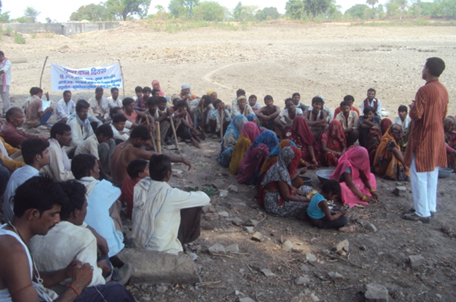
Chandelas and Bundelas were the two major dynasties in the region which took keen interest in conserving water as a means of supporting livelihood and development of region. Chandela tanks were constructed by stopping the flow of water in rivulets flowing between hills by erecting massive earthen embankments, having width of 60m to 120m or more. These hills with long stretches of quartz reefs running underneath them, acted as natural ground water barrier helping to trap water between the ridges. The earthen embankments were supported on both sides with walls of coarse stones, forming a series of stone steps. These tanks were made up with traditional construction materials of lime and mortar and with such material these tanks are surviving even after thousand years now. Chandela tanks usually had a convex curvature somewhere in the middle of the embankment; many older and smaller tanks were constructed near the human settlement or near the slopes of a cluster of hills. These tanks served to satisfy the drinking water needs of villagers and cattle.
These tanks are currently facing several problems as siltation of their beds, encroachment of their catchment, illegal occupation of the tank bed and gross neglect by the Government as well as the community.
In Bangai the main tank- Budhasagar faced the problem of seepage due to which it could not store water. Earlier, the villagers depended on this pond for domestic use and irrigation facilities, because of which it formed the lifeline of the village. Because of seepage, the people of Bangai had to face acute water shortage in the summer season and eventually started migrating.
In 2011, Parmarth, started the Integrated water Resource Management project with the support of the European Union and Welthungerhilfe. The villagers were organized through Pani Panchayats and the community action plan was developed after a series of meetings. The plan unequivocally emphasized on restoration and development of the Budhsagar tank so that loss of water due to seepage could be stopped. Technical estimation for the tank was prepared for repairing of this pond.
The Pani Panchayat members were made responsible for purchasing of material, implementation of work and financial & physical monitoring of the entire work. The project contributed Rs 1,75,000/ for the construction work and the rest was contributed as labour by the community.
As a result of this collective community effort, the tank is full of water after the monsoons. The wells downstream have also been recharged and there is sufficient drinking water available for the people now. It has become a model of people’s management of this vital water resource and has earned the admiration of people from the neighbouring areas as well.
Pani Panchayat members Gangaram, Dhaniram, Gyanwati, Raju etc had pledged and worked together for revival of this pond and today they feel proud to see their efforts being successful. As Gangaram and Gyanwati, members of Pani Panchayat put it, “the water filled tank now assures us drinking water all year round and the villagers will not migrate to cities”. Approximately 75 families have benefited through irrigation water supply in 317 acres of land.
Several Government officials have visited the site and the Government has shown interest to take up similar activities through their existing programmes.




